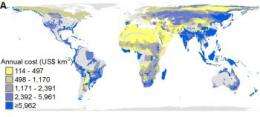What is the true cost of conservation worldwide? Billions, annually

The world's governments will need to invest billions annually to reduce the extinction risk for all known threatened species, a new study by University of Sussex biologist Dr Jörn Scharlemann and an international team of scientists concludes.
But according to the researchers, the cost of such investment, equivalent to just 20 per cent of what the world spends on soft drinks each year, would be more than repaid by the economic, scientific and social benefit of conserving our precious natural heritage.
Dr Jörn Scharlemann, Reader in Ecology and Conservation at University of Sussex and former Senior Scientist at the United Nations Environment Programme World Conservation Monitoring Centre, produced maps of total conservation cost for birds.
He also worked out the potential savings that could be made, as some of the conservation actions for one species would probably benefit other species whose distributions overlap, for example by establishing protected areas, removing predators from an island and improving public education.
Dr Scharlemann says: "This first estimate of the required investment for nature conservation highlights how relatively little it costs to save nature worldwide.
"Although the sums may be large, investing in conservation makes economic sense because of the payback in terms of benefits and services people receive in return, such as climate change mitigation or crop pollination.
"The investment needed to conserve globally threatened animals and plants, and safeguard important sites of global conservation significance is equivalent to the UK's annual interest payments on public debt."
Previous global commitments have failed to reduce the rate of loss of biodiversity, so in 2010, all parties to the Convention on Biological Diversity (CBD) adopted a new strategic plan, including 20 ambitious yet achievable targets, collectively known as the Aichi Targets, to be met by 2020. The cost of achieving these targets had not been estimated until now.
The study – published in the journal Science this week as the Convention on Biological Diversity continues (until 19 October) in Hyderabad, India – offers the first authoritative figures estimating the cost of meeting two of the Aichi Targets that are most urgent: saving threatened species and protecting key sites for conservation.
A total of US$4 billion (around £2.5 billion) would be needed annually to prevent human-driven extinction and improve the status of all known globally threatened animal and plant species, with a further US$76 billion (around £42 billion) needed each year to protect and effectively manage sites of global conservation significance.
The Science study. "Financial Costs of Meeting Two Global Biodiversity Conservation Targets: Current Spending and Unmet Needs," drew on available data for birds, which is the best known class of organism, to estimate the costs of meeting conservation targets for all nature.
To assess the costs of safeguarding sites, the authors examined terrestrial sites of global conservation significance for birds (the 11,731 Important Bird Areas [IBAs] identified by conservation organisation BirdLife). IBAs represent the largest systematically identified global network of important sites for biodiversity (not just birds), but only 28 per cent are completely covered by existing protected areas.
Effectively managing these already-protected sites, says the study, would cost US$7.2 billion each year.
Expanding protection and effective management to the remaining IBAs increases the total to $57.8 billion per year. These additional protected areas would increase the proportion of the world's land surface covered by protected areas to just over 17 per cent, the threshold governments have committed to in the Aichi Targets.
Globally important sites have also been systematically identified for mammals, amphibians and some reptile, fish, plant and invertebrate groups in a number of countries.
Of these sites, 71 per cent already qualify as IBAs. Assuming this relationship holds worldwide, the costs of protecting and effectively managing a global network of sites for nature more broadly is estimated to be US$76.1 billion annually.
"The shortfalls we have identified highlight a clear and urgent need to scale up investment in biodiversity conservation substantially", says the paper's lead author, Donal McCarthy, Environmental Economist at BirdLife International and the UK's Royal Society for the Protection of Birds (RSPB).
"But the total costs are very small relative to the likely costs of inaction. The total is just 1-4% of the net value of ecosystem services being lost annually, for which estimates range from $2 to $6.6 trillion. More prosaically, the total required is less than 20% of annual global consumer spending on soft drinks."
More information: Financial Costs of Meeting Two Global Biodiversity Conservation Targets: Current Spending and Unmet Needs, D McCarthy et al, can be viewed on the Science web pages.
Journal information: Science
Provided by University of Sussex












